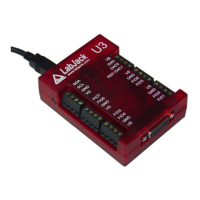Mecha y
the dig uffer is
used. or
an op-a
ote that the U3 DACs can source enough current to control almost any SSR and even some
ctor on the U3 and accepts up to 12 industry standard I/O modules (designed for
pto22 G4 modules and similar).
two channel
odule that plugs into the U3 screw-terminals, and allows two digital lines to each hold off up to
.9 Timers/Counters
abled, Counter1 disabled, and TimerCounterPinOffset=0:
nical relays require more control current than SSRs, and cannot be controlled directly b
ital I/O on the U3. To control higher currents with the digital I/O, some sort of b
Some options are a discrete transistor (e.g. 2N2222), a specific chip (e.g. ULN2003),
mp.
N
mechanical relays, and thus can be a convenient way to control 1 or 2 relays.
The RB12 relay board is a useful accessory available from LabJack. This board connects to the
DB15 conne
O
Another accessory available from LabJack is the LJTick-RelayDriver. This is a
m
50 volts and sink up to 200 mA. This allows control of virtually any solid-state or mechanical
relay.
2
The U3 has 2 timers (Timer0-Timer1) and 2 counters (Counter0-Counter1). When any of these
timers or counters are enabled, they take over an FIO/EIO line in sequence (Timer0, Timer1,
Counter0, then Counter1), starting with FIO0+TimerCounterPinOffset. Some examples:
1 Timer enabled, Counter0 dis
FIO0=Timer0
1 Timer enabled, Counter0 disabled, Counter1 enabled, and TimerCounterPinOffset=2:
FIO2=Timer0
FIO3=Counter1
led, Counter0 enabled, Counter1 enabled, and TimerCounterPinOffset=8:
2 Timers enab
IO0=Timer0
0
mple,
pear anywhere from FIO0 to EIO1, depending on TimerCounterPinOffset and
0 is enabled. On the other hand, FIO5 (for example), is always on the screw
IO5, and AIN5 (if enabled) is always on that same screw terminal.
ote that Counter0 is not available with certain timer clock base frequencies. In such a case, it
E
EIO1=Timer1
EIO2=Counter
EIO3=Counter1
Timers and counters can appear on various pins, but other I/O lines never move. For exa
Timer1 can ap
whether Timer
terminal labeled F
N
does not use an external FIO/EIO pin. Counter0 does not use an external An error will result if
an attempt is made to enable Counter0 when one of these frequencies are configured.
Similarly, an error will result if an attempt is made to configure one of these frequencies when
Counter0 is enabled.
Applicable digital I/O are automatically configured as input or output as needed when timers and
counters are enabled, and stay that way when the timers/counters are disabled.
See Section 2.8.1 for information about signal connections.
30

